Morgan Dieschbourg, Dylan Fox-Arnold, and Em Jahn
Introduction:
This week, our class set about analyzing Cato’s description of traditional bread-making techniques in De Agricultura (a text from 165 BCE) through experimental archaeology on Carleton College’s Mai Fete Island. Specifically, we looked at six different bread-and-cheese-based recipes outlined in the text: placenta, spira, scriblita, erneum, globi, and encytum.
In part, our focus surrounded the recipe’s use of farro; specifically, the ambiguity in the language surrounding kneading the softened farro “by hand.” Our experiment investigated the meaning of this phrase by completing the various recipes by physically breaking individual kernels of farro with our hands, using a mortar and pestle to crush the farro, or using a metate/quern to work the farro into a paste. Each of the aforementioned methods of processing farro into a paste is a plausible interpretation of the text.
In addition to our questions regarding methods of producing farro paste, our class was interested in the different starches mentioned in the text, as flour is also listed as an additional ingredient. Our groups experimented with the ratio of emmer flour to farro paste throughout multiple trials, seeking to determine whether using farro or flour in equal or unequal amounts would impact the final product and/or the cooking process.
Since we are attempting to clarify details regarding a process from a text that is thousands of years old and the sole authoritative source on unleavened bread making in Rome, our ability to unequivocally say whether or not a certain method was definitively used is severely limited. Our experiment aims to gauge the plausibility of each method through personal experience, meaning that many of our conclusions come from qualitative rather than quantitative data.
Through this analysis, we hope to discover more about what life for breadmakers – and eaters of unleavened products – in Classical Rome, before the advent of large-scale bakeries, could have been like. As these techniques would have been used by most Roman households before natural leavening came into practice, a better understanding of both the time and techniques required of bread production allows us to better understand the day-to-day lives of many Romans who made their own food. Hopefully, this experiment helps us to do just that.
Our general research questions and goals for the lab were as follows:
- What is the most plausible interpretation of Cato’s description of kneading farro “by hand?” What are the advantages and disadvantages of each method?
- Does the ratio of farro to emmer flour change the taste, texture, and cooking process of Cato’s ancient baked products? If so, how?
- Gaining a better understanding of pre-leavening Roman bread production.
Procedure:
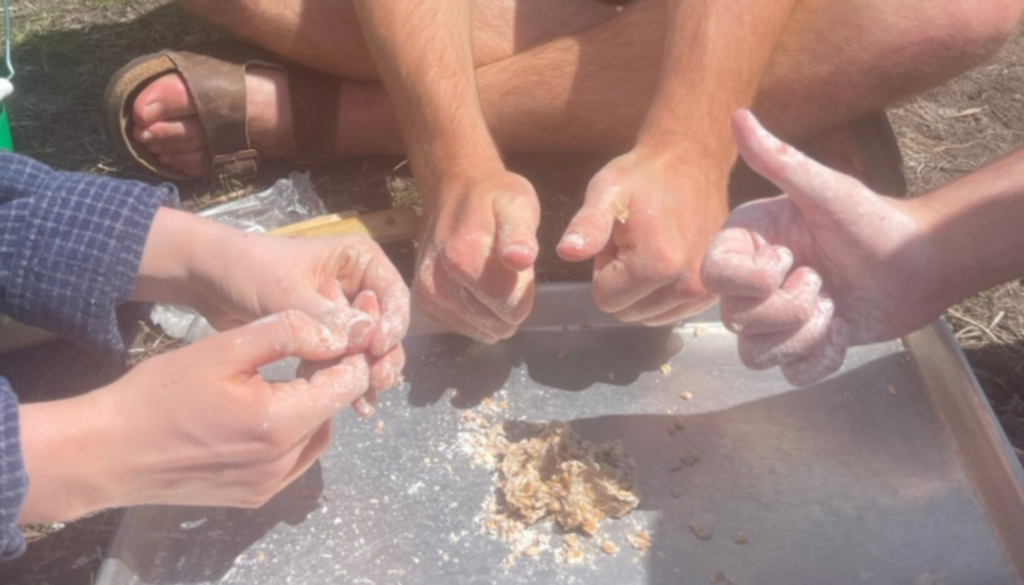
The first steps undertaken in most of the forms of bread prepared in the lab involved constructing the tracta. Four of the six types of bread that we constructed during this lab are formed of a similar structure, consisting of a base dough wrapped around layers of farro dough (tracta) alternating with a cheese-based filling. Thus, the major variations between placenta, spira, scriblita, and erneum are primarily found in flavor and cooking style variations rather than actual structure.
The first step of constructing the first iterations of the tracta was to form its dough. Using water-softened farro, we ground it into a paste using the various methods discussed above. Once the substance, known as alica, had acquired a thick, sticky consistency, it was mixed with emmer flour, salt, and water and kneaded until it formed a tacky, stretchy dough. This dough was then divided into four sections, which were rubbed with olive oil and formed into shapes. For placenta, scriblita, and erneum, four flat discs were formed and allowed to harden to a leathery texture by being exposed to the air as the rest of the ingredients were prepared. To construct the spira, three of these discs were replaced by spirals of coiled dough. In the second iteration of each of these dishes, tracta were prepared without using the farro-based alica, but otherwise were assembled in precisely the same manner.
Once the tracta had been constructed, they were stacked on a sheet of dough made with only bread flour, sandwiched together with layers of a cheese-based filling. For placenta, spira, and erneum, this filling consisted of well-mashed feta and honey, while the filling for the scriblita included only feta. The base dough was then folded up to surround the layers of tracta and filling, forming a dome-shaped mass of dough. The final step of preparation for these four breads was to apply heat, which was done in two different ways. For the placenta, spira, and scriblita, a cast-iron pot was preheated using a wood fire, after which time the bread was placed inside it. The pot was then covered with a lid, and cooked with additional coals for about an hour, at which point the lid was removed to reveal a cohesive mass of cooked dough and cheese. The erneum, rather than being cooked in this manner, was cooked in a double-boiler style, using a similar cast-iron pot placed on a grate over a wood fire. Rather than being placed directly in the water, the erneum was cooked within a smaller steel pot, in a lower-heat setting that resulted in a much less bread-like result.
The final two breadstuffs, globi and encytum, were constructed in a way entirely different from the other four, although still using many of the same ingredients. Rather than being baked or boiled, these foods were fried in oil, but again utilized an open above-ground fire pit as a heat source. To construct the initial iterations of both breadstuffs, more mashed feta was combined with the same farro-based alica used in the other breads. Variations were also attempted using only emmer flour and water rather than the more substantial alica, as well as by replacing the feta cheese with ricotta. The differences between globi and encytum are seen primarily in the cooking style – to construct globi, the dough was formed into balls, which were then fried whole in olive oil, while the encytum was pressed through a grater into the oil to form much smaller chunks of material.
Data Summary:
Placenta: (Group A; quotes and data from Ellie Simon’s “Group A Placenta Data”)
Table 1a: Ingredients from Placenta Trials 1 & 2
| Ingredients: | Amount (Trial 1): | Amount (Trial 2): |
| Farro | 5.6 oz | None |
| Water | 1.9 oz | 2.75 oz |
| Salt | Large pinch | Large pinch |
| Emmer flour | 4.6 oz | 5.6 oz |
| Olive oil | ~2 tbsp | ~2 tbsp |
| Feta | 2 lb | 2 lb |
| Honey | Unspecified | Unspecified |
| Bay leaves | Unspecified | Unspecified |
As seen in Table 1a, the primary difference between the first and second trials for the placenta was the balance of starches: Trial 1 used 5.6 oz of farro and 4.6 oz of emmer flour, whereas Trial 2 used exclusively emmer flour (5.6 oz., or an increase of 1 oz). The other difference between the two trials was the amount of water used – 1.9 oz. in Trial 1, 2.75 oz. in Trial 2. In Trial 1, it took 19 minutes of mashing the farro with the metate to reach the desired consistency of paste using the metate to grind.
Other quantitative data included the weights of tracta (doughy discs within the bread separated by cheese/honey filling) between Trials 1 and 2. As displayed in Table 1b, tracta from Trial 1 were consistently larger than tracta from Trial 2. These disparities between the two trials may be attributable to either the lack of farro or human error. In a cast-iron pot that had been preheating over hot coals for around 90 minutes, Trial 1’s placenta took 12 minutes to cook (determined based on its “nice, orange-brown” exterior) as opposed to a 30-minute cooking time for the second trial.
Table 1b: Tracta Weights from Placenta Trials 1 & 2
| Tracta Number: | Weight (Trial 1): | Weight (Trial 2): | Difference in Weight (Trial 1 – Trial 2): |
| 1 | 4.00 oz | 2.30 oz | 1.70 oz |
| 2 | 3.40 oz | 2.05 oz | 1.35 oz |
| 3 | 2.45 oz | 2.00 oz | 0.45 oz |
| 4 | 3.70 oz | 1.80 oz | 1.90 oz |
Qualitative Observations:
Taste: The placenta’s bread elements were described as “meaty and smokey” (potentially because the pots had been used for other cooking purposes previously), and the filling was described as being “sweet and salty” and “the best part” of the dish.
Texture: The placenta from Trial 1 was described as having a “tough outer shell” with a “soft and gooey” interior that saw the tracta merge with the cheesy filling – in other words, “the layers of tracta had disappeared.” Trial 2’s placenta was described as being “even more rubbery than the first” with a soggier interior.
Smell: The placenta’s smell was described as a mixture of “smoke, fresh bread, and the umami smell of cheese.”
Spira: (Group B, quotes and data from Chris O’Mara’s “Group B Data – Grain Lab 1”)
The ingredients for the spira-making group’s tracta are listed in Table 2. Between the two trials, the primary difference is that there is no farro paste in the spira from Trial 2 as opposed to the 5.6 oz of farro paste in Trial 1. The paste from Trial 1 was achieved by grinding the farro into a paste for roughly 20 minutes using a mortar and pestle. It should also be noted that the ingredients for both the base dough and cheese mixture stayed the same between trials – bread flour (4.8 oz) and water (3.9 oz) for the base dough, and feta (1 lb) and honey (5 oz) for the cheese mixture. The spira cooked for approximately 35 minutes during Trial 1 and 27 minutes during Trial 2 – the second spira failed to hold together, breaking apart while cooking in the cast-iron pot.
Table 2: Tracta Dough Ingredients from Spira Trials 1 & 2
| Ingredients: | Amount (Trial 1): | Amount (Trial 2): |
| Farro paste | 5.6 oz | 0.0 oz |
| Emmer flour | 4.6 oz | 4.9 oz |
| Bread Flour | 0.0 oz | 0.7 oz |
| Water | 2.3 oz | 2.8 oz |
| Salt | 2 pinches | 2 pinches |
Qualitative Observations:
Texture: Described as “slightly underbaked,” the first trial’s spira had tracta that were “quite spongey” when compared to the base dough. Group members attributed this sponginess to the presence of farro paste in the first spira’s tracta, an ingredient not present in the base dough. This theory was given further credence by the second spira – made without farro paste, group members found the tracta to be far less spongey than the tracta from Trial 1.
Additionally, group members found that maintaining Cato’s recommended ratios of cheese and honey, when scaled down, made the spira “nearly impossible to close using the base dough (even after doubling)” and that “the cake was incredibly cheese forward.”
Scriblita: (Group C, quotes and data from Ruby Becker’s “Group C Data: Grain 1”)
Ingredients used in the two trials of scriblita can be seen in Table 3. Similar to the spira, the primary difference between the two groups was the absence of farro in Trial 2. Here, the amount of emmer flour was greatly increased in Trial 2. The farro was ground into a paste using a combination of “smushing and kneading” with hands for approximately 14 minutes. It should again be noted that the base doughs and cheese fillings for both the first and second trials were made using the same proportions – bread flour (4.6 oz) and water (3.5 oz) for the base, and feta (1 lb) for the filling. Finally, cook times between the two trials varied considerably: the first scriblita was cooked for just 27 total minutes with a ten-minute cooling time, whereas the second was cooked for a total of 44 minutes with the same ten-minute cooling time.
Table 3: Tracta Dough Ingredients from Scriblita Trials 1 & 2
| Ingredient: | Amount (Trial 1): | Amount (Trial 2): |
| Farro | 5.6 oz | 0 oz |
| Emmer flour | 4.6 oz | 11.2 oz |
| Salt | A pinch | A pinch |
| Water | 1.9 oz | 2.4 oz |
Qualitative Observations:
Texture: The scriblita from Trial 1 (with farro) was described as having a harder, crunchier exterior than the second scriblita (no farro). Like the first trial of the spira-making group, the first scriblita’s tracta were spongey and maintained their separation from the cheesy filling. The second trial’s tracta merged with the cheesy filling, failing to produce the same sponginess and resulting in a “slightly soggy” and “mushy” end product.
Erneum: (Group D, quotes and data from Will Brewster’s “Group D Lab Data: Grain I”)
Table 4: Tracta Dough Ingredients from Erneum
| Ingredients: | Amount: |
| Farro | 5.6 oz |
| Emmer flour | 4.6 oz |
| Water | ~1.9 oz |
| Salt | Large pinch |
Qualitative Observations:
Farro paste formation: Using a mortar and pestle, group members found that a circular grinding motion was the easiest to achieve the desired consistency of the paste. Additionally, the presence of whitish “stringy bits” in the ground farro indicated that the paste had started to form from the individual grains. Using the mortar and pestle, it took around 11.5 minutes to achieve the desired texture.
Kneading: Kneading by hand took about 23.5 minutes to achieve the desired cohesiveness (passing the “window test”). This process took longer than anticipated.
Cooking: In a steel pot, the erneum cooked for 1 hour and five minutes. The steel pot bobbed around in the boiling water – perhaps a result of using steel rather than the specified clay pots outlined in Cato’s text.
Texture: The structure of the erneum verged on nonexistent, as it was “difficult to get out of the oven.” Additionally, the tracta failed to separate the erneum’s interior into discernable tiers, and the tracta and the base had a crunchiness akin to pita chips.
Globi: (Group E, quotes and data from Marta Kondratiuk’s “Ritual Lab Data: Group E”)
Four trials were conducted for the globi: the first used exclusively farro, the second exclusively emmer flour, the third a combination of farro and flour, and the fourth a substitution of ricotta for feta cheese. The exact amounts of each trial’s ingredients can be found in Table 5a. Trial 4 was more or less for fun, but it’s included in Tables 5a and 5b as well. Timelines for the four trials can be found in Table 5b.
Table 5a: Ingredients for Globi Trials 1, 2, & 3
| Ingredients: | Amount (Trial 1): | Amount (Trial 2): | Amount (Trial 3): | Amount (Trial 4): |
| Feta | 0.5 lb | 0.5 lb | 0.5 lb | 0 lb |
| Ricotta | 0 lb | 0 lb | 0 lb | 8.0 oz |
| Farro | 2.8 oz | 0 oz | 1.5 oz | 1.7 oz |
| Emmer flour | 0 oz | 4.37 oz | 1.3 oz | 2 oz |
| Olive oil (for frying) | Undetermined | Undetermined | Undetermined | Undetermined |
| Honey* | Light drizzle | Light drizzle | Light drizzle | Light drizzle |
| Poppyseeds* | Light sprinkle | Light sprinkle | Light sprinkle | Light sprinkle |
*indicates garnish
Table 5b: Timelines of Preparation/Cooking for Globi Trials 1, 2, 3, & 4
| Event: | Trial 1 Time: | Trial 2 Time: | Trial 3 Time: | Trial 4 Time: |
| Grinding of farro. | 17 min (by hand) | NA | 4 min (mortar and pestle) | 4 min (mortar and pestle) |
| Ingredients mixed by hand. | 2 min | 3 min | 3 min | 4 min |
| Globi fried over a fire. | 6 min | 7 min | 7 min | 10 min |
Qualitative Observations:
Farro paste formation: In Trials 1, 3, and 4, different methods of smashing farro grain into a paste were implemented – “by hand” in the literal sense for Trial 1, and using a mortar and pestle the second time. This group found the grinding by hand to be an “unending and meticulous process,” taking 17 minutes to complete as opposed to the far more efficient method of using the mortar and pestle which only took 4 minutes.
Farro vs. flour: The cooking process of globi from Trials 1 and 2 showed apparent differences between farro and flour’s reactions with the frying pan. Farro, the stickier of the two substances and the easier to mold into stable balls, stuck to the bottom of the frying pan and was therefore difficult to maintain its shape while frying. The flour-based globi, while requiring more water to mold into balls that would keep their shape, were much easier to rotate in the pan without turning into misshapen fritters. It is also possible that some of these differences in the frying process are attributable to the learning curve of the group and the gaining of experiential knowledge through repeated trials.
Taste: The taste of globi was “very fatty but good” (Jake Oberg) and comparable to the “little bit of the cheese that drips down and gets a little crispy” when making a grilled cheese sandwich (Dylan Fox-Arnold). Although Trial 4 and the ricotta were not explicitly the focus of our lab, the mildness of the ricotta highlighted how the saltiness of the feta actually benefitted the overall taste of the globi.
Texture: The texture of the globi, while retaining a degree of crispiness throughout all four trials, experienced a fair degree of variation. The farro-based globi from Trial 1 seemed the most crispy of the four – verging on burnt – while the flour-based globi (Trial 2) were generally more enjoyably crispy, better complimenting the “softness of the feta.”
Encytum: (Group F, quotes and data from Bee Candelaria’s “Group F Data: Grain I”)
Differences between trials for encytum mirrored the general process of globi. Regarding the grinding of farro in Trials 1, 3, and 4, grinding by hand was a longer and more arduous process than using the mortar and pestle – exact times can be found in Table 6b.
Table 6a: Ingredients for Encytum Trials 1, 2, 3, &4
| Ingredients: | Amount (Trial 1): | Amount (Trial 2): | Amount (Trial 3): | Amount (Trial 4): |
| Farro | 2.8 oz | NA | 1.5 oz | 1.5 oz |
| Emmer flour | NA | 6.2 oz | 1.3 oz | 1.3 oz |
| Feta | 8 oz | 8 oz | 8 oz | 8 oz |
| Water | NA | 1 oz | 1 oz (feta brine) | 1 oz |
Table 6b: Timelines of Preparation/Cooking for Encytum Trials 1, 2, 3, & 4
| Event: | Trial 1 Time: | Trial 2 Time: | Trial 3 Time: | Trial 4 Time: |
| Grinding of farro. | 15 min (by hand) | NA | 10 min (mortar and pestle) | 10 min (mortar and pestle) |
| Combining ingredients. | 5 min | — | 5 min | 5 min |
| Frying in oil | — | — | — | — |
Qualitative Observations:
Taste: The second trial (emmer flour only) was cited as the best-tasting of the four trials. Additionally, group members concurred with the findings of Group E that the saltiness of the feta worked better with the recipe than did the more neutral ricotta.
Findings:

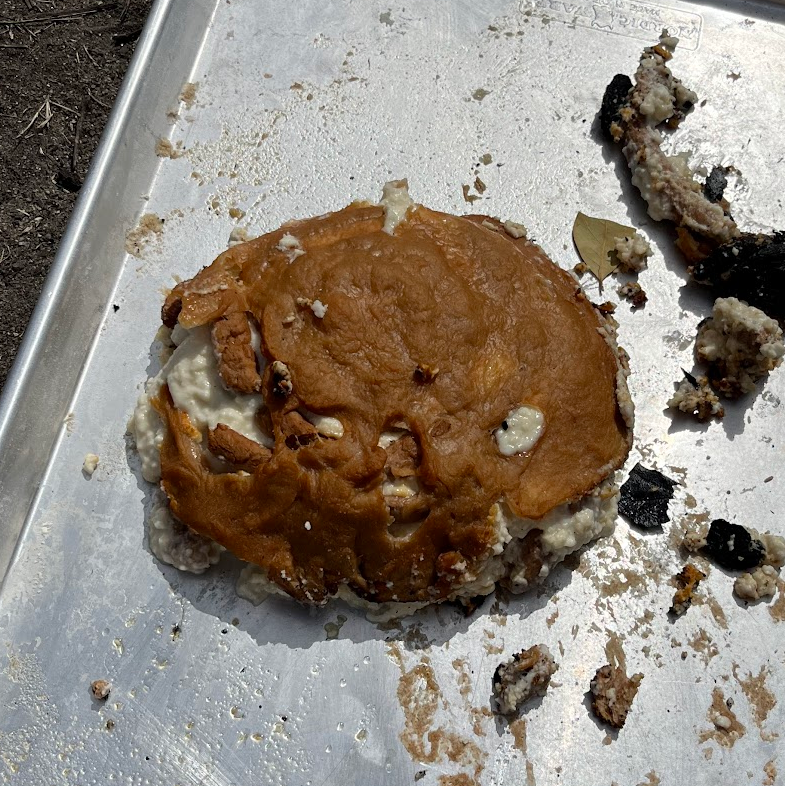
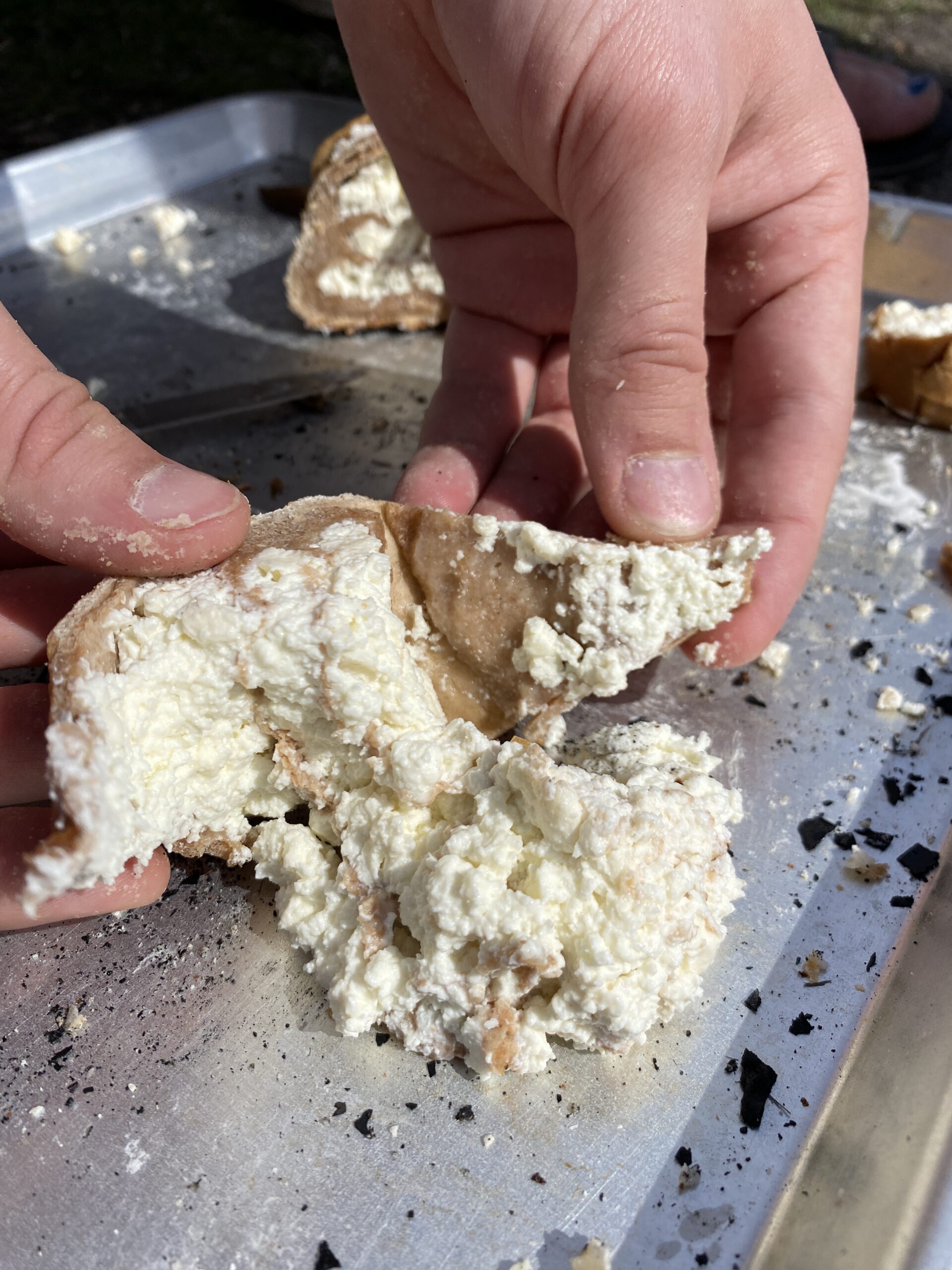
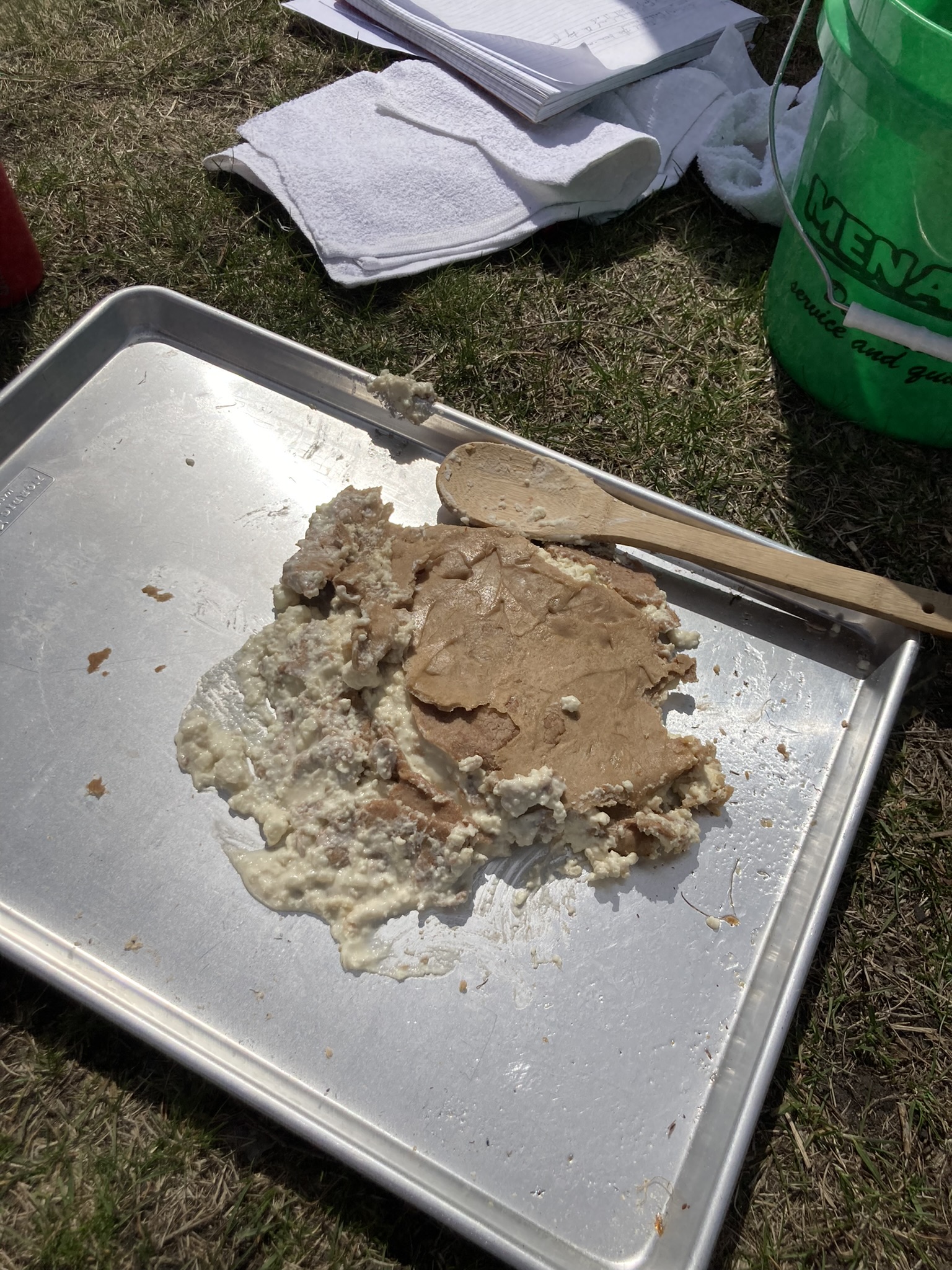
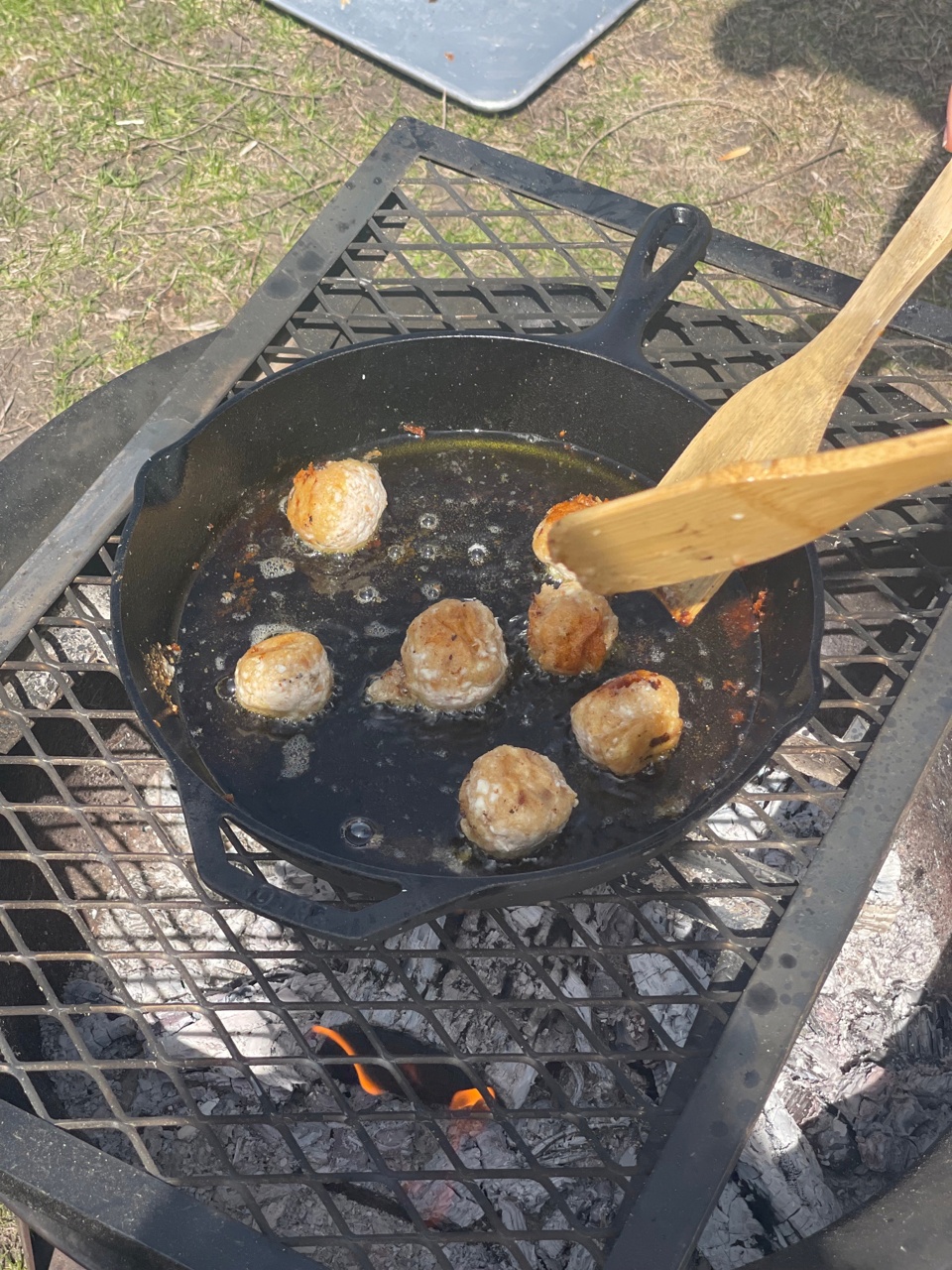
In regards to our first research question for the lab involving the technique in the mashing of the farro by hand and with the mortar and pestle, the sense of efficiency in terms of time taken to grind the farro to a specific consistency, varies across the six lab groups depending on which technique was used. Beginning with Group A making placenta, the metate was used to mash the farro that was recorded in 19 minutes. Group B, tasked to make spira, used the mortar and pestle to grind their farro which took about 20 minutes. Group C, making scriblita, applied a combination of “smushing and kneading” in mashing their farro with their hands that took about 14 minutes. Group D, constructing erneum, used the mortar and pestle to complete the desired consistency by grinding the farro in 11.5 minutes. Thus, in analyzing each of these four groups responsible for making a specific ancient bread product of Cato’s, there is no clear way to assign a correlation between efficiency and the grinding method in smashing the farro using a mortar and pestle or hand mashing the farro given the wide range of times recorded by each the groups in the smashing of the farro. However, when assessing factors that can influence this step in the lab, it is evident that there were a variety of people in each of the lab groups collectively involved in this step in the grinding of farro. Given that point, results regarding the efficiency of time taken to grind the farro to a specific consistency could have been more consistent if there was a specific person assigned to the mashing of the farro and a specific method had been implemented instead of involving the metate, mortar and pestle, and hand mashing.
While the two groups in charge of globi underwent a slightly different process of the mashing of farro – being able to conduct four trials opened the opportunity to change the grinding method that resulted in an increase in efficiency of mashing the farro. Group E recorded that in trial one, hand mashing the farro took 17 minutes while in Trials three and four, using the mortar and pestle, the grinding of the farro took 4 minutes. While group F recorded that in Trial one, hand mashing the farro took 15 minutes and with the mortar and pestle, grinding took 10 minutes for both trial three and four. So in the case of globi, with the usage of the mortar and pestle, there is an increase in efficiency in grinding the farro.
Following the idea posed in the second research question involving the impact the inclusion of the emmer flour has on the taste, texture, and cooking processes in each of the groups, there was great variability in how emmer flour influenced the elements listed above. Group A, covering Placenta, indicated that with the increase in the emmer flour in trial 2, there was a change in texture, specifically noting that the placenta in trial 2 was more rubbery and had a more gooey interior than in trial 1. Given
Trial 1’s placenta took 12 minutes to cook in comparison to a 30-minute cooking time for the second trial, the analysis of trial 2’s placenta texture is relevant here in recognizing the pattern in following groups in that the more time the bread cooks, the more moisture it loses, which produces this rubbery texture of the product of trial 2. This is again seen in Group B, Spira, in that group members recognize that the spira was less spongy than in Trial 1. Group C, Scriblita, also noted that the same sponginess as seen in trial 1 was not replicated; rather than in trial 2, the end product was “mushy.” Group D, Erneum, communicated that the erneum in Trial 2 has a crunchy texture like “pita chips” while its interior was undercooked. In these four groups, there is a recognizable pattern in that with an increase in cooking time, the interior of the bread products lose moisture and are left undercooked. Both groups E and F recorded the greatest amount of emmer flour used in Trial 2, which led to collective agreement among group members that it was best tasting and complimented the feta. In terms of the cooking process, Group E in Trial 2 recorded that with the flour based globi, water was required to enable the globi to maintain its shape during the frying of the globi. Thus, the flour based globi was more crispy than in other trials, along with the inclusion of emmer flour making it more difficult to form into balls, affecting the taste, texture, and cooking process.
Conclusions & Reflections:
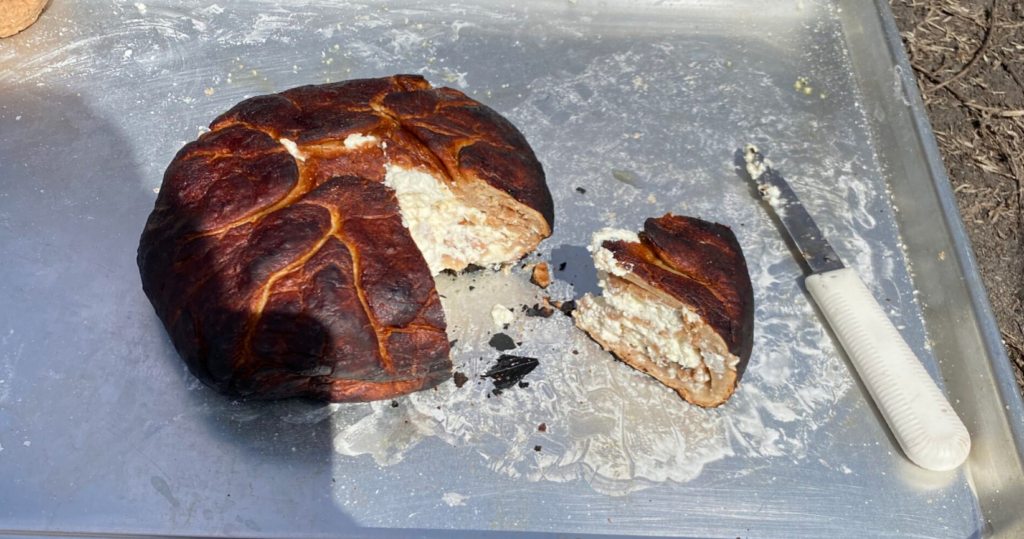
In reflection, this lab led to a heightened sense of understanding of the creation of ancient unleavened bread products, guided by Cato’s recipes. Along with drawing from knowledge gained through learning about Cato’s description of ancient bread making techniques, insight from Ellen in her research surrounding Cato’s ancient bread products was provided. Following initial curiosity about the technique in the mashing of the farro by hand versus the mortar and pestle, the expectation of consistency of the paste was not described in the text. Consequently, difficulties did arise when determining when the farro paste was ready. Ellen had said to aim for a “marshmallow” consistency for this paste, describing the targeted consistency to be stringy and sticky. Ellen had also indicated that this step in making the tracta (applicable for groups A-D) only took her about 6 minutes to reach the desired paste consistency, which led into thinking about the link between experience and the evolution of knowledge and strategy that is acquired throughout the bread making process. Along with the idea of the gaining of experience and knowledge in this process, the research question involving the connection between taste, texture, and the cooking process involving emmer flour is interesting to consider given that additional cooking time and experience in preparing the product resulted in notable changes to taste and texture. Even though each group was divided up and assigned to various tasks, the sense of cohesion in sharing in this lab experience was conveyed in the enthusiasm with which each group were excited to taste all end products. In terms of the reaction of group members to the final bread products, the appearance of the bread and the presence of particular utensils determined the behavior in how the bread was viewed and eaten.
Overall, this lab was a great opportunity to learn about ancient unleavened bread production and truly gain an understanding of bread making processes through experimentation. By re-creating the equipment and ingredients that were implemented into these ancient bread making processes, experience of this environment was also an essential part of this lab. The access to resources required for bread making is also a factor taken into account throughout the lab along with the required commitment in both time and technique in bread making. This lab allowed us to learn about what life was like for an ancient Roman bread maker and situate bread as the foundation of life and civilization while fostering an understanding of the evolution of the bread we know today.


0 thoughts on “LAB SUMMARY WEEK 6: Tracta, Alica, and Catonian Breadstuffs”